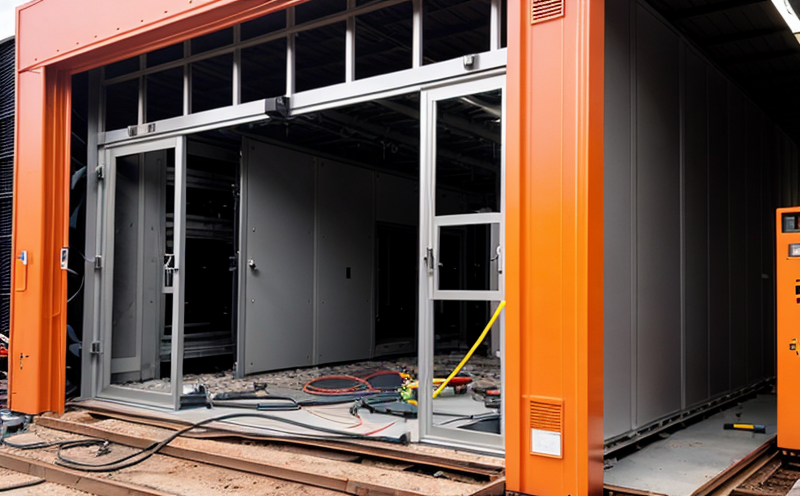SAE J1798 Thermal and Functional Safety Testing of Battery Modules
The SAE J1798 standard is pivotal in ensuring the safety and reliability of electric vehicle (EV) battery modules by addressing thermal management issues and functional safety concerns. This service focuses on testing according to the SAE J1798 protocol, which evaluates whether a battery module can withstand various stressors without compromising performance or integrity.
The SAE J1798 standard is designed for lithium-ion battery modules intended for use in passenger vehicles. It aims to prevent thermal runaway and other hazardous conditions that could lead to catastrophic failure of the battery pack. The testing procedure involves subjecting a battery module to several environmental and operational stressors, including high-temperature cycling, overcharging, and short-circuit scenarios.
The process begins with specimen preparation where the battery module is conditioned according to specific guidelines provided by SAE J1798. This ensures that the test results are not influenced by initial conditions but rather reflect the true performance of the module under stress. The testing apparatus used includes climate chambers capable of simulating extreme environmental conditions, power supplies for charging and discharging tests, and thermal imaging equipment to monitor temperature changes during the test.
During the testing process, the battery module is subjected to a series of tests designed to replicate real-world scenarios that could potentially lead to safety issues. These include:
- High-temperature cycling: The battery module is cycled through high temperatures, typically up to 50°C or more, to simulate prolonged exposure to heat.
- Overcharging: The module is subjected to overcharging conditions to assess its ability to handle excess electrical input without overheating or failing.
- Short-circuit testing: A short circuit is induced in the battery module to evaluate its response and containment of fault currents, which is critical for preventing fire hazards.
The test results are meticulously recorded using advanced software systems that integrate with the laboratory’s data management platform. This ensures accurate documentation and traceability of each test run. Once all tests have been completed, a detailed report is generated, outlining the performance metrics and compliance status against SAE J1798 standards.
The significance of this testing cannot be overstated in today's EV market where safety remains a paramount concern. By adhering to SAE J1798 guidelines, manufacturers can ensure that their battery modules meet stringent quality control benchmarks, thereby enhancing overall vehicle reliability and passenger safety.
Why It Matters
The importance of the SAE J1798 standard cannot be overstated in the context of electric vehicles (EVs). As the global automotive industry shifts towards more sustainable and environmentally friendly transportation solutions, ensuring the safety and reliability of battery modules becomes increasingly critical. The SAE J1798 testing protocol is essential for several reasons:
Firstly, it helps prevent thermal runaway—a phenomenon where excessive heat leads to further heating and potential failure of a battery module. This can result in hazardous situations such as fires or explosions, posing significant risks to both passengers and the environment.
Secondly, by conducting thorough functional safety tests according to SAE J1798, manufacturers can identify and mitigate potential weaknesses early in the development process. This proactive approach not only enhances product quality but also reduces the likelihood of costly recalls or warranty claims post-launch.
Thirdly, compliance with these standards is often a prerequisite for certification by regulatory bodies such as the National Highway Traffic Safety Administration (NHTSA) and the European Union’s New European Driving Cycle (NEDC). Meeting these requirements ensures that your product meets industry best practices and can be marketed globally without unnecessary delays.
Finally, maintaining high safety standards through rigorous testing according to SAE J1798 fosters consumer trust. In an era where electric vehicles are gaining popularity, potential buyers look for assurances regarding the safety features of their chosen vehicle. Demonstrating adherence to such stringent protocols reassures stakeholders about the robustness and reliability of your product.
Industry Applications
- Electric Vehicles (EVs): SAE J1798 testing is crucial for EV manufacturers looking to ensure their battery modules meet stringent safety standards. This testing helps prevent incidents such as thermal runaway, which could lead to dangerous situations.
- Pedelecs and E-bikes: For personal transportation devices equipped with lithium-ion batteries, SAE J1798 ensures that the battery modules are robust enough to handle various operational conditions without compromising safety.
- Stationary Energy Storage Systems (ESS): In renewable energy applications where large-scale storage systems are employed, ensuring the stability and safety of the battery is paramount. SAE J1798 testing plays a vital role in this context by providing a framework for assessing thermal management capabilities.
- Solar-Powered Vehicles: For vehicles that rely on solar energy to power their batteries, it's essential to test against SAE J1798 standards. This ensures that the battery modules can efficiently manage solar input and store excess energy safely.
The application of SAE J1798 extends beyond automotive applications into various sectors including renewable energy, consumer electronics, and even military and aerospace industries where high-performance batteries are required.
International Acceptance and Recognition
The SAE J1798 standard has garnered significant recognition from both industry stakeholders and regulatory bodies around the world. Its adoption is not limited to North America but extends globally, reflecting its importance in ensuring consistent safety standards across different markets.
In Europe, where stringent environmental regulations are enforced, manufacturers often seek certification that their products comply with SAE J1798. Similarly, in China and other Asian countries, adherence to these guidelines is increasingly becoming a benchmark for quality. The United States Department of Transportation (USDOT) also recognizes the value of this standard, integrating it into its vehicle safety protocols.
Moreover, several international standards organizations such as ISO, IEC, and EN have referenced or incorporated aspects of SAE J1798 in their own guidelines for battery module testing. This cross-referencing underscores the widespread acceptance and applicability of this standard across diverse regions and industries.





